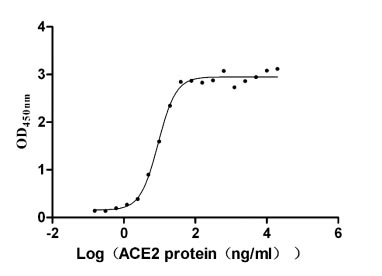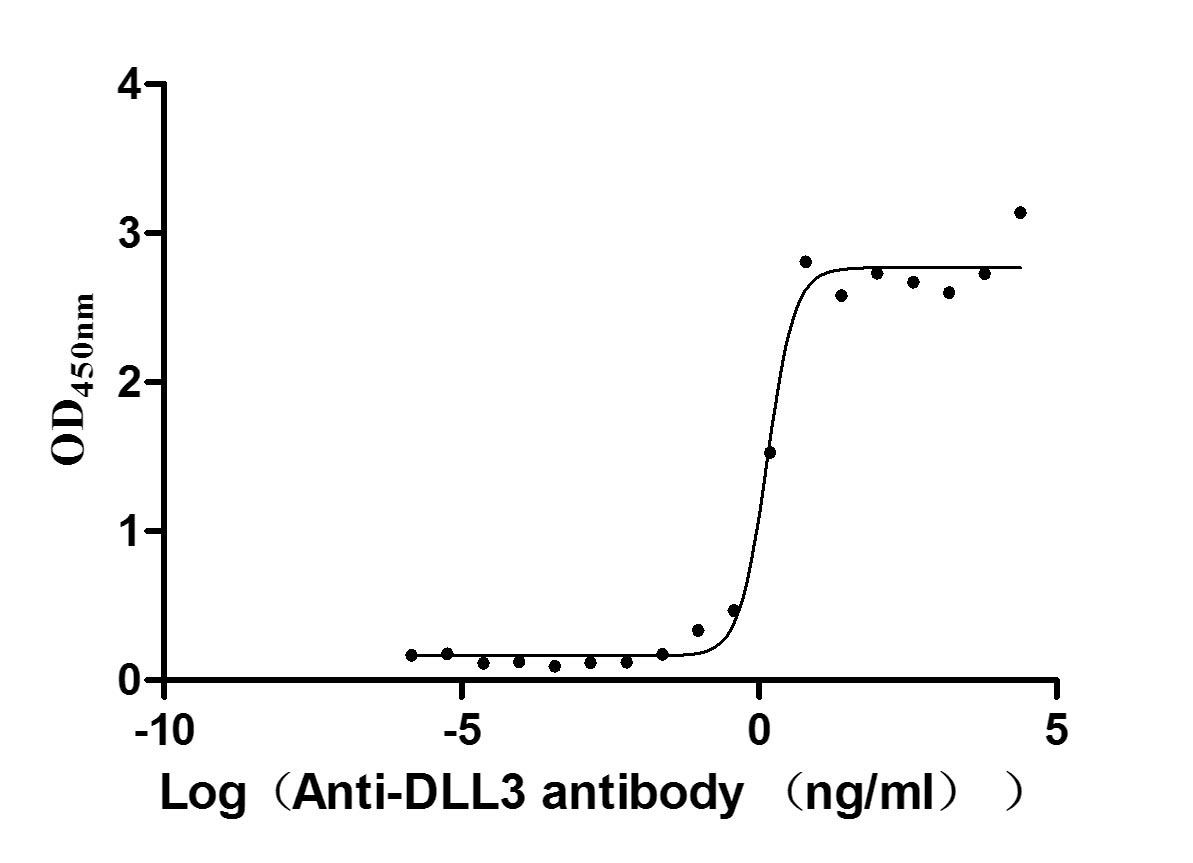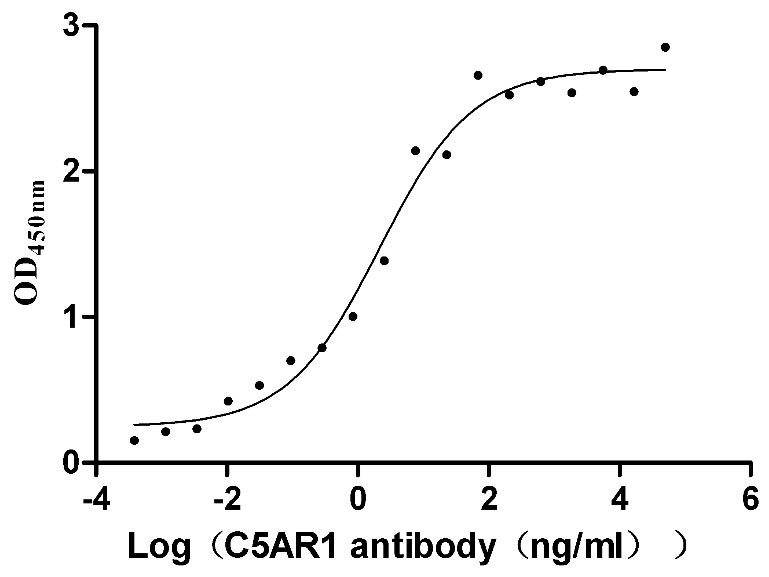Recombinant Human ATP-binding cassette sub-family C member 11 (ABCC11), partial
-
中文名稱:Recombinant Human ATP-binding cassette sub-family C member 11(ABCC11) ,partial
-
貨號:CSB-YP846641HU
-
規(guī)格:
-
來源:Yeast
-
其他:
-
中文名稱:Recombinant Human ATP-binding cassette sub-family C member 11(ABCC11) ,partial
-
貨號:CSB-EP846641HU
-
規(guī)格:
-
來源:E.coli
-
其他:
-
中文名稱:Recombinant Human ATP-binding cassette sub-family C member 11(ABCC11) ,partial
-
貨號:CSB-EP846641HU-B
-
規(guī)格:
-
來源:E.coli
-
共軛:Avi-tag Biotinylated
E. coli biotin ligase (BirA) is highly specific in covalently attaching biotin to the 15 amino acid AviTag peptide. This recombinant protein was biotinylated in vivo by AviTag-BirA technology, which method is BriA catalyzes amide linkage between the biotin and the specific lysine of the AviTag.
-
其他:
-
中文名稱:Recombinant Human ATP-binding cassette sub-family C member 11(ABCC11) ,partial
-
貨號:CSB-BP846641HU
-
規(guī)格:
-
來源:Baculovirus
-
其他:
-
中文名稱:Recombinant Human ATP-binding cassette sub-family C member 11(ABCC11) ,partial
-
貨號:CSB-MP846641HU
-
規(guī)格:
-
來源:Mammalian cell
-
其他:
產(chǎn)品詳情
-
純度:>85% (SDS-PAGE)
-
基因名:ABCC11
-
Uniprot No.:
-
別名:ABCC 11; ABCC11; ABCCB_HUMAN; ATP binding cassette protein C11; ATP binding cassette sub family C (CFTR/MRP) member 11; ATP binding cassette sub family C member 11; ATP binding cassette transporter MRP8; ATP binding cassette transporter sub family C member 11; ATP-binding cassette sub-family C member 11; EWWD; MRP8; Multi resistance protein 8; Multidrug resistance associated protein 8; Multidrug resistance-associated protein 8; OTTHUMP00000164191; WW
-
種屬:Homo sapiens (Human)
-
蛋白長度:Partial
-
蛋白標簽:Tag?type?will?be?determined?during?the?manufacturing?process.
The tag type will be determined during production process. If you have specified tag type, please tell us and we will develop the specified tag preferentially. -
產(chǎn)品提供形式:Lyophilized powder
Note: We will preferentially ship the format that we have in stock, however, if you have any special requirement for the format, please remark your requirement when placing the order, we will prepare according to your demand. -
復溶:We recommend that this vial be briefly centrifuged prior to opening to bring the contents to the bottom. Please reconstitute protein in deionized sterile water to a concentration of 0.1-1.0 mg/mL.We recommend to add 5-50% of glycerol (final concentration) and aliquot for long-term storage at -20℃/-80℃. Our default final concentration of glycerol is 50%. Customers could use it as reference.
-
儲存條件:Store at -20°C/-80°C upon receipt, aliquoting is necessary for mutiple use. Avoid repeated freeze-thaw cycles.
-
保質期:The shelf life is related to many factors, storage state, buffer ingredients, storage temperature and the stability of the protein itself.
Generally, the shelf life of liquid form is 6 months at -20°C/-80°C. The shelf life of lyophilized form is 12 months at -20°C/-80°C. -
貨期:Delivery time may differ from different purchasing way or location, please kindly consult your local distributors for specific delivery time.Note: All of our proteins are default shipped with normal blue ice packs, if you request to ship with dry ice, please communicate with us in advance and extra fees will be charged.
-
注意事項:Repeated freezing and thawing is not recommended. Store working aliquots at 4°C for up to one week.
-
Datasheet :Please contact us to get it.
相關產(chǎn)品
靶點詳情
-
功能:ATP-dependent transporter of the ATP-binding cassette (ABC) family that actively extrudes physiological compounds, and xenobiotics from cells. Participates in physiological processes involving bile acids, conjugated steroids and cyclic nucleotides. Stimulates the ATP-dependent uptake of a range of physiological lipophilic anions, including the glutathione S-conjugates leukotriene C4 and dinitrophenyl S-glutathione, steroid sulfates such as dehydroepiandrosterone 3-sulfate (DHEAS) and estrone 3-sulfate, glucuronides such as estradiol 17-beta-D-glucuronide (E(2)17betaG), the monoanionic bile acids glycocholate and taurocholate, and methotrexate. Enhances also the cellular extrusion of cAMP and cGMP. Confers resistance to anticancer drugs, such as 5-fluorouracil (5-FU) and methotrexate. Probably functions to secrete earwax. Required for the secretion of components contributing to axillary odor formation.
-
基因功能參考文獻:
- The previous findings of a previously unreported homozygous genotype for both the Delta27 and A alleles suggest that the Delta27 deletion might have occurred in the A allele of ABCC11 gene with the 538G>A mutation. PMID: 30047321
- our study has provided conclusive evidence for the association of rs17822931 in the ABCC11 with the susceptibility of AO in the Chinese Han population PMID: 28485377
- Serum levels of MRP8/MRP14 and MRP6 were up-regulated in patients with Graves' disease (GD) and Hashimoto's thyroiditis (HT). In addition, mRNA expression of MRP proteins in PBMCs and the thyroid gland was markedly elevated in these patients. PMID: 29656212
- High MRP8 expression is associated with Rheumatoid Arthritis. PMID: 29530998
- ABCC11 c.1637C>T polymorphisms affects fluoropyrimidine toxicity to leukocytes PMID: 27001120
- Our results confirmed the association between NAF yield and earwax phenotype through ABCC11 genotype. Combined with the recency of last birth, ABCC11 genotype should be considered in the design of studies utilizing NAF as a biosample. PMID: 27027309
- Tenofovir disoproxil fumarate is a new substrate of ABCC11. PMID: 28167562
- These results suggest that N-linked glycosylation is important for the protein stability of ABCC11, and physiological alteration in glucose may affect the ABCC11 protein level and ABCC11-related phenotypes in humans, such as axillary osmidrosis. PMID: 27281343
- The present study shows that the protein expression of ABCC10 significantly associates with overall survival and the expression of ABCC11 with disease-free interval of colorectal cancer patients PMID: 27468921
- ABCC11 protein was detected in the human axillary apocrine glands of the 538GG homozygote or 538GA heterozygote, not in the 538AA homozygote. These findings would contribute to a better understanding of the molecular basis of axillary osmidrosis. PMID: 28212277
- No Association of the rs17822931 Polymorphism in ABCC11 was found with Breast Cancer Risk in Koreans. PMID: 27268641
- Presents a simple isothermal genotyping method capable of detecting single nucleotide polymorphisms in the human ATP-binding cassette transporter ABCC11 gene and its application to the clinical diagnosis of axillary osmidrosis. PMID: 27057547
- identified c.1637C>T (T546M), previously associated with 5-FU-related toxicity, as a novel functionally damaging ABCC11 variant exhibiting markedly reduced transport function of 5-FdUMP, the active cytotoxic metabolite of 5-FU. Detailed analysis of 14 subpopulations revealed highest allele frequencies of c.1637C>T in Europeans and Americans (up to 11%) compared with Africans and Asians (up to 3%). PMID: 25896536
- The ABCC11 gene SNP of the 538 G>A allele was associated with a downregulation of the mRNA expression of ApoD in the apocrine glands, which may indicate a role for the ABCC11 gene in the mediation of osmidrosis PMID: 25633187
- A single nucleotide polymorphism in ABCC11 affects the cerumen volatile organic compounds profiles of individuals from African, Caucasian, and Asian descent. PMID: 25501636
- role in the generation of axillary malodour PMID: 24533866
- ABCC11 gene SNP results in lower levels of axillary odour in the A/A homozygotes, but A/A subjects still produce noticeable amounts of axillary odour. Axillary skin metabolites/bacterial genera/personal hygiene behaviours are also influenced by this SNP. PMID: 24076068
- The rs17822931 SNP in ABCC11 is associated with wet earwax and bromhidrosis in a chinese family. PMID: 23970085
- Our results suggest that a specific type of toxicity, leukopenia, is associated with a particular variant of ABCC11, which is different from the earwax and eQTL variants. PMID: 24024896
- High expression of ATP-binding cassette transporter ABCC11 in breast tumors is associated with aggressive subtypes and low disease-free survival. PMID: 23288347
- Cerumen types, determined by CYP2D6 and the incidence of breast cancer is significantly higher among the moist cerumen type. Further studies on the polymorphism of this gene are scheduled in relation to carcinogenesis and malignancy. PMID: 23350374
- overview of the discovery and genetic polymorphisms inABCC11; focus on the impact of ABCC11 538G>A on the apocrine phenotype, patients' response to nucleoside-based chemotherapy and the potential risk of breast cancer [review] PMID: 21182469
- The expression of ABCC11 protein appears to be decreased in most breast cancer (BC). PMID: 21423094
- Earwax-associated polymorphism in ABCC11 is not associated with breast cancer. PMID: 21165769
- Data show that latitude is associated with allele frequency of ABCC11 rs17822931-A in Asian, Native American, and European populations, implying that the selective advantage of rs17822931-A is related to an adaptation to a cold climate. PMID: 20937735
- Study shows that Japanese women with wet earwax have a higher relative risk of developing breast cancer than those with dry earwax. The ABCC11 SNPs that determine these phenotypes should be further investigated. PMID: 21187511
- Results showed that ABCC11 may be one of the biomarkers for MTA treatment in adenocarcinomas. PMID: 20718756
- The SmartAmp method-based genotyping of the ABCC11 gene would provide an accurate and practical tool for guidance of appropriate treatment PMID: 19625231
- ABCC11 has a role in the biochemical formation of human axillary odor PMID: 19710689
- The allele frequencies of the ABCC11 locus within ancient populations on the Northern Japanese island of Hokkaido, were investigated. PMID: 19557017
- alternative splice variants and gene expression PMID: 11688999
- Impaired 2',3'-dideoxy-3'-thiacytidine accumulation in T-lymphoblastoid cells as a mechanism of acquired resistance independent of multidrug resistant protein 4 with a possible role for ATP-binding cassette C11. PMID: 12133003
- Results suggest that MRP8 participates in physiological processes involving bile acids, conjugated steroids, and cyclic nucleotides and indicate that this pump has complex interactions with its substrates. PMID: 15537867
- Transport function together with the localization of the ABCC11 protein in vicinity to GABA A receptors is consistent with a role of ABCC11 in dehydroepiandrosterone 3-sulfate release from neurons. PMID: 16359813
- An SNP, 538G --> A (rs17822931), in the ABCC11 gene is responsible for determination of earwax type in several ethnic groups. PMID: 16444273
- High expression of MRP8 is associated with reduced intracellular levels of cytosine arabinoside and results in acute myeloid leukemia. PMID: 19240178
- Data suggest that a single-nucleotide polymorphism in the ABCC11 gene has an effect on the N-linked glycosylation of ABCC11, intracellular sorting, and proteasomal degradation of the variant protein. PMID: 19383836
- Wet/dry types of earwax are determined by the c.538G>A single-nucleotide polymorphism in the ABCC11 gene. PMID: 19644513
顯示更多
收起更多
-
亞細胞定位:Cell membrane; Multi-pass membrane protein. Vacuole membrane. Cytoplasmic vesicle membrane. Apical cell membrane; Multi-pass membrane protein.
-
蛋白家族:ABC transporter superfamily, ABCC family, Conjugate transporter (TC 3.A.1.208) subfamily
-
組織特異性:Expressed in ceruminous apocrine gland (at protein level). Expressed in many tissues. Not expressed in kidney, spleen and colon. Highly expressed in breast cancer. Expressed at moderate levels in normal breast and testis and at very low levels in liver, b
-
數(shù)據(jù)庫鏈接:
Most popular with customers
-
Recombinant Severe acute respiratory syndrome coronavirus Spike glycoprotein (S), partial (Active)
Express system: Mammalian cell
Species: Human SARS coronavirus (SARS-CoV) (Severe acute respiratory syndrome coronavirus)
-
Recombinant Human Delta-like protein 3 (DLL3), partial (Active)
Express system: Mammalian cell
Species: Homo sapiens (Human)
-
Recombinant Human C5a anaphylatoxin chemotactic receptor 1 (C5AR1)-VLPs (Active)
Express system: Mammalian cell
Species: Homo sapiens (Human)
-
Recombinant Human Tumor necrosis factor ligand superfamily member 15(TNFSF15) (Active)
Express system: Mammalian cell
Species: Homo sapiens (Human)





-AC1.jpg)









